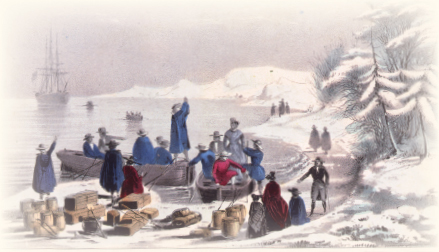1587

One hundred sixteen people, including Eleanor and Ananias Dare, settle on Roanoke Island (now part of North Carolina) as part of the second effort of the British to colonize the New World. Their daughter, Virginia Dare, is the first child to be born to English parents on what is now American soil. Unfortunately, this entire group vanished. A U.S. stamp commemorating Virginia Dare’s birth and the “Lost Colony” is later issued.
1607

One hundred four British men and boys settle in Jamestown (later part of the state of Virginia) as part of continuing attempts by the British to colonize the New World. Jamestown is named in honor of James I, the king of England. This group of pioneers was sponsored by the Virginia Company of London.
1608

Pocahontas saves a Jamestown colonist, Captain John Smith, from execution by her father, Algonquin chief Powhatan.
1619

Purchased by the Virginia colony, the first African slaves (seventeen men and three women) arrive at Jamestown. By the end of the transatlantic slave trade, an estimated five hundred thousand people have been “exported” to the United States; 30 percent of them are women.
1620

More than a hundred Pilgrims, men, women, and children, leave England aboard the ship Mayflower in search of religious freedom. When the ship arrives at Plymouth Rock, its passengers establish the first settlement in what will become the state of Massachusetts.
1622
Mary Johnson A slave named Mary arrives in Jamestown; she later becomes one of the first freed slaves in the United States who has the right to choose her own surname (Johnson). A common practice at the time is to choose the surname of a benefactor; thus it is believed that someone with the surname of Johnson helped Mary and her husband attain their freedom.
1636

Harvard College is established in Massachusetts; its mission is to educate men to become ministers.
1637

Anne Hutchinson expresses religious views that are not appreciated by some influential members of the local government. Their accusations result in her becoming the first female defendant in a Massachusetts court and, upon a finding of her guilt, her expulsion from the Massachusetts Bay Colony in 1638. She and much of her family settle in Rhode Island.
1644

Upon the death of her husband, Mistress Sarah Jenney becomes the first woman to run a grain mill. In 1652, this Pilgrim and resident of the Plymouth Colony receives a land grant.
1645

Lady Deborah Moody founds Gravesend (now a neighborhood in Brooklyn, New York) based on a town patent she receives from the Dutch. Moody becomes the first female landowner in the New World, which also makes her eligible to vote.
1648

Margaret Brent emigrates from England to the Maryland settlement in 1638 with one of her sisters and two of her brothers. She claims a land grant, conducts business, and appears in court. On his deathbed, Governor Leonard Calvert appoints her as his executor, and her ensuing actions enable the settlement to survive. In 1648, she appears before the legislature to request two votes—one for herself, as she is a landowner, and another in her role as Lord Baltimore’s attorney.
1650

Anne Bradstreet, who emigrates from England to Massachusetts with the Puritans in 1630, is the first American poet and the first American woman to have a book published in what will become the United States. She writes poetry while raising eight children and serving as hostess for her husband, who becomes governor. Her first book of poetry, The Tenth Muse Lately Sprung up in America, by a Gentlewoman of Those Parts, is published in England in 1650 by her brother-in-law, who takes her poems without her knowledge. The American edition is published in 1678.










